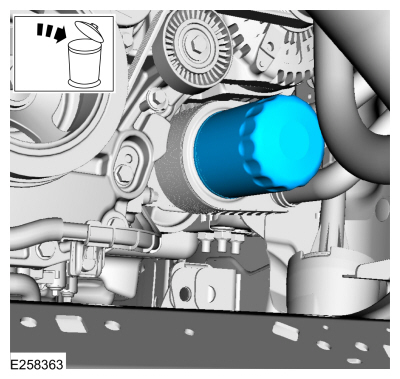Lincoln Nautilus: Engine System - General Information / Oil Pressure Test - Gasoline. General Procedures
Oil Pressure Test 2.7L EcoBoost & 3.3L Duratec & 5.0L Ti-VCT
-
NOTE: It is necessary to disconnect the battery to avoid setting any DTCs that could cause the PCM to command the oil pressure to other than what should be observed from a correctly operating system during the oil pressure test.
Disconnect the battery ground cable.
For additional information, refer to: Battery Disconnect and Connect (414-01) .
-
Remove the EOP sensor. Refer to the appropriate 303-14 Electronic Engine Controls section.
-
NOTE: The VDOP (variable displacement oil pump) solenoid and the EOP sensor must be connected and functional during the oil pressure test.
Assemble the oil pressure adaptors as needed to the oil gallery port. Install the commercially available oil pressure gauge.- 1. M12x1.5 Male to 1/8 NPT Female adaptor
- 2. 1/8 NPT Male to two 1/8 NPT Female T-fitting
- 3. Commercially available oil pressure gauge
- 4. 1/8 NPT Male to M12x1.5 Female adaptor
- 5. Oil pressure sensor
 |
-
Connect the EOP sensor electrical connector.
-
Connect the battery ground cable.
For additional information, refer to: Battery Disconnect and Connect (414-01) .
Oil Pressure Test 3.5L EcoBoost & 3.5L PowerBoost
-
With the vehicle in NEUTRAL, position it on a hoist.
For additional information, refer to: Jacking and Lifting (100-02) .
-
Remove and discard the oil filter.
 |
-
Connect a GearWrench 3289 Oil Pressure Tester Kit or equivalent oil pressure gauge to the oil filter housing.
All vehicles
-
Run the engine until normal operating temperature is reached.
-
Run the engine at the specified rpm and record the gauge reading.
-
The oil pressure should be within specifications. Refer
to the 303-01 specifications procedure for each engine for the
acceptable oil pressure range and specific vehicle requirements.
-
If the pressure is not within specification, check the following possible sources:
Visual Inspection Chart
Mechanical - Insufficient oil
- Oil leakage
- Worn or damaged oil pump
- Oil pump screen cover and tube
- Excessive main bearing clearance
- Excessive connecting rod bearing clearance
- Chain tensioner leak
Oil Pressure Test 3.5L EcoBoost & 3.5L PowerBoost
-
Remove the commercially available oil pressure gauge.
-
Install a new manufacturer-specified oil filter.
 |
-
Check and refill the oil as needed, using new
manufacturer-specified oil. Refer to the Specifications in the
appropriate 303-01 section.
 |
Oil Pressure Test 2.7L EcoBoost & 3.3L Duratec & 5.0L Ti-VCT
-
Disconnect the battery ground cable.
For additional information, refer to: Battery Disconnect and Connect (414-01) .
-
Disconnect the EOP sensor electrical connector.
-
Remove the commercially available oil pressure gauge. Remove the oil pressure adaptors.
-
Install the EOP sensor. Refer to the appropriate 303-14 Electronic Engine Controls section.
-
Connect the battery ground cable.
For additional information, refer to: Battery Disconnect and Connect (414-01) .
 Oil Leak Inspection - Gasoline. General Procedures
Oil Leak Inspection - Gasoline. General Procedures
NOTE:
If an overnight drive is done, the fan air or road air blast can cause erroneous readings.
NOTE:
When diagnosing engine oil leaks, the source and location of the leak must be positively identified prior to repair...
 Piston Diameter. General Procedures
Piston Diameter. General Procedures
Check
NOTE:
Refer to the appropriate Section 303-01 for the specification.
Measure the piston diameter 90 degrees from the piston
pin and down from the top of the piston to the point indicated...
Other information:
Lincoln Nautilus 2018-2026 Owners Manual: Switching Android Auto On and Off
Enabling Android Auto with USB (If Equipped) Connect your device to a USB port. Follow the instructions on the touchscreen. Note: Certain features of the system are not available when you are using Android Auto. Enabling Android Auto with Wireless Pair your device to Bluetooth...
Lincoln Nautilus 2018-2026 Service Manual: Power Liftgate Motor. Removal and Installation
Removal Remove the D-pillar trim panel. Refer to: D-Pillar Trim Panel (501-05 Interior Trim and Ornamentation, Removal and Installation). NOTICE: Take extra care not to crease the headliner. Release the retainers and position aside the headliner...
Categories
- Manuals Home
- 1st Generation Nautilus Owners Manual
- 1st Generation Nautilus Service Manual
- Fuel Quality
- USB Ports
- Interior Lamp Function. Adjusting the Instrument Panel Lighting Brightness. Ambient Lighting. Interior Lighting – Troubleshooting
- New on site
- Most important about car
Parking Aid Indicators. Parking Aids – Troubleshooting
Parking Aid Indicators

The system provides object distance indication through the information and entertainment display.
As the distance to the object decreases, the indicator waves and the lines move toward the vehicle icon. If there is no object detected, the distance indicator lines are grey.